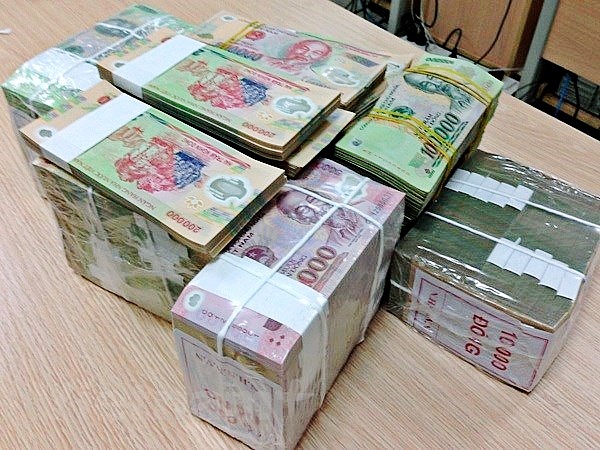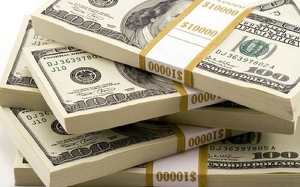Exchange rates set to put pressure on bank lending
As of last week, the State Bank of Vietnam (SBV) continued its drawdown, absorbing almost $422 million through bills with a continually declining interest rate of 0.8 per cent compared to previous sessions. Cumulatively, over 14 issuance sessions, the SBV has mopped up approximately $6.57 billion. Persistent rate drops indicate prevalent excess liquidity.
 |
| Exchange rates set to put pressure on bank lending (Photo:VNA) |
In its latest release, the SBV reported a credit growth of 6.92 per cent at the end of September, year-to-date. This suggests two key insights: firstly, the narrowing USD-VND interest rate differential acts as a buffer against exchange rate pressures; and secondly, there’s an anticipated credit demand resurgence in the year’s latter months.
Amid a volatile international environment marked by unfavourable shifts, Vietnam’s currency is poised to encounter significant pressures in Q4/2023.
A senior leader at BIDV, one of Vietnam’s largest state-owned banks, expressed concerns over the recent adverse international signals.
“The global commodity prices, especially oil, are trending upwards due to supply constraints, making inflation control for countries even more challenging,” he said.
“Moreover, there’s the possibility of the US Federal Reserve maintaining high-interest rates, which might even surge further. The adverse impacts from the European Union and China’s economies might also radiate to other nations, bolstering the defensive sentiment towards the USD as a global safe-haven. Given these dynamics, the Dollar Index might approach the 107-108 mark in Q4.”
Domestically, the landscape does not seem favourable either. “The VND/USD interest rate differential is projected to improve towards the end of the year, but it’s primarily estimated to remain negative, hovering around -3 per cent per annum on an average one-week term,” the executive said.
Additionally, the outlook for domestic foreign currency supply and demand remains less than optimistic, given the slowdown in capital flows into emerging markets. Coupled with this, the demand for foreign currency may rise as imports potentially become more robust towards the year’s end.
Tran Thi Ha My, chief economist at Viet Dragon Securities Corporation, said, “We maintain our view that the exchange rate will oscillate around 24,500 VND/USD and decrease by year’s end. The risk to this forecast is if the USD surpasses the 110 thresholds, compelling the SBV to reduce foreign reserves to counter a steeper devaluation of VND.”
Tran Anh Anh, head of Macroeconomics and Market Strategy at KB Securities, voiced similar concerns.
“The end-of-year exchange rate pressure remains high due to the sustained high difference between USD and VND interest rates. Additionally, the robust trend of the USD continues, and the recovering economy drives the demand for imports,” he said.
He further projected that the exchange rate would rise around 3.5 per cent compared to the beginning of the year, reaching VND24,460 by year-end.
“Despite the VND’s relative stability compared to other economies, the exchange rate pressure might stifle the downward trajectory of interest rates in the near future,” Anh added.
A new survey on business trends for Q4 by the SBV revealed that 71-75.7 per cent of credit institutions considered the “interest rate, credit, and exchange rate policies” as the most critical internal factors positively impacting their business situation in consecutive quarters (Q2, Q3 of 2023) and for the entire year.
Financial reports for Q2 from 27 listed banks, including Agribank, showed that the net profit from foreign exchange (carry trade) business in the first half of 2023 reached nearly VND12 trillion ($505.9 million), an 18 per cent increase compared to the same period the previous year. This increase is over seven times the growth rate of the total operating income.
The key growth drivers remain the Vietcombank, VietinBank, BIDV, and Agribank, who together accounted for $350.2 million of net profit from foreign exchange business, a 30 per cent rise from last year, and constituting 69 per cent of the industry’s total net profit.
The profit is primarily derived from spot foreign exchange trading activities, a steady revenue source emanating from the spread between the buy and sell rates.
A banker told VIR last week, “The exchange rate has increased by 3.5 per cent since the start of the year. While carry trade activities do add some pressure on the exchange rate, the overwhelming pressure still stems from the worsening international landscape.”
 | Exchange rate pressure to soothe by end of 2023: expert Pyon Young Hwan, director of Global Trading Centre at Shinhan Bank Vietnam, shared his take with VIR's Thuy Vinh on the interest rate situation globally and in Vietnam, and challenges and development prospects for the country’s economy in late 2023 and beyond. |
 | Central bank keeps close eye on forex market movements The State Bank of Vietnam is monitoring and taking action to moderate exchange rate movements in the face of weakening regional currencies. |
What the stars mean:
★ Poor ★ ★ Promising ★★★ Good ★★★★ Very good ★★★★★ Exceptional
Related Contents
Latest News
More News
- Tax sector wraps up 2025 and sets priorities for next year (December 25, 2025 | 14:00)
- A tipping point for digital and hybrid wealth management in Vietnam (December 23, 2025 | 13:33)
- $250 million deal targets women-owned SMEs, sustainable agriculture (December 22, 2025 | 17:40)
- Stock market posts resilient 2025 performance (December 19, 2025 | 18:17)
- Citi Vietnam receives 2025 AmCham CSR recognition (December 19, 2025 | 16:35)
- As global green supply chain reshapes, will Vietnam be left behind? (December 19, 2025 | 08:00)
- Banks gear up for massive capital increases (December 18, 2025 | 17:04)
- Securing capital and efficiency for Vietnam’s 2026-2030 growth ambitions (December 17, 2025 | 10:00)
- Energy sector in need of blended finance mechanisms (December 17, 2025 | 09:00)
- Vietnam still has room to mobilise capital for sustainable growth (December 17, 2025 | 08:57)

 Tag:
Tag:





















 Mobile Version
Mobile Version